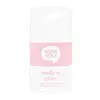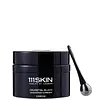What's inside
What's inside
 Key Ingredients
Key Ingredients

 Benefits
Benefits

 Concerns
Concerns

 Ingredients Side-by-side
Ingredients Side-by-side

Water
Skin ConditioningPrunus Armeniaca Kernel Oil
MaskingEmulsifying Wax Nf
Glycerin
HumectantHelianthus Annuus Seed Oil
EmollientOlea Europaea Fruit Oil
MaskingCocos Nucifera Oil
MaskingButyrospermum Parkii Butter
Skin ConditioningStearic Acid
CleansingZinc Oxide
Cosmetic ColorantAllantoin
Skin ConditioningAvena Sativa Meal Extract
SoothingTocopherol
AntioxidantSodium Hyaluronate
HumectantXanthan Gum
EmulsifyingOryza Sativa Bran Oil
EmollientHydrolyzed Centella Asiatica Extract
AntioxidantPyrus Malus Fruit Extract
Skin ConditioningSodium Ascorbyl Phosphate
AntioxidantVitis Vinifera Seed Extract
AntimicrobialHibiscus Sabdariffa Callus Extract
AntioxidantPhenoxyethanol
PreservativeEthylhexylglycerin
Skin ConditioningCitrus Medica Peel Oil
Jasminum Officinale Oil
MaskingOrchis Mascula Extract
Skin ConditioningTetramethyl Acetyloctahydronaphthalenes
MaskingSantalum Album Oil
MaskingBenzyl Benzoate
AntimicrobialBenzyl Cinnamate
PerfumingBenzyl Salicylate
PerfumingLinalool
PerfumingLimonene
PerfumingWater, Prunus Armeniaca Kernel Oil, Emulsifying Wax Nf, Glycerin, Helianthus Annuus Seed Oil, Olea Europaea Fruit Oil, Cocos Nucifera Oil, Butyrospermum Parkii Butter, Stearic Acid, Zinc Oxide, Allantoin, Avena Sativa Meal Extract, Tocopherol, Sodium Hyaluronate, Xanthan Gum, Oryza Sativa Bran Oil, Hydrolyzed Centella Asiatica Extract, Pyrus Malus Fruit Extract, Sodium Ascorbyl Phosphate, Vitis Vinifera Seed Extract, Hibiscus Sabdariffa Callus Extract, Phenoxyethanol, Ethylhexylglycerin, Citrus Medica Peel Oil, Jasminum Officinale Oil, Orchis Mascula Extract, Tetramethyl Acetyloctahydronaphthalenes, Santalum Album Oil, Benzyl Benzoate, Benzyl Cinnamate, Benzyl Salicylate, Linalool, Limonene
Water
Skin ConditioningIsopropyl Myristate
EmollientHydrogenated Palm Oil
EmollientCetearyl Alcohol
EmollientCaprylic/Capric Triglyceride
MaskingGlyceryl Stearate Se
EmulsifyingGlycerin
HumectantGlyceryl Stearate
EmollientPEG-100 Stearate
Benzyl Alcohol
PerfumingCeteareth-25
CleansingPEG-7 Hydrogenated Castor Oil
EmulsifyingZinc Oxide
Cosmetic ColorantSodium Hyaluronate
HumectantAesculus Hippocastanum Seed Extract
Skin ConditioningSodium Ascorbyl Phosphate
AntioxidantAcetyl Cysteine
AntioxidantMaltodextrin
AbsorbentSilica
AbrasiveGlycyrrhiza Glabra Root Extract
BleachingCentella Asiatica Extract
CleansingPrunus Armeniaca Kernel Oil
MaskingPolysorbate 20
EmulsifyingPEG-20 Glyceryl Laurate
EmulsifyingTocopherol
AntioxidantLinoleic Acid
CleansingRetinyl Palmitate
Skin ConditioningDiamond Powder
AbrasiveXanthan Gum
EmulsifyingPhenoxyethanol
PreservativeEthylhexylglycerin
Skin ConditioningDiethylhexyl Syringylidenemalonate
Skin ProtectingCitric Acid
BufferingParfum
MaskingWater, Isopropyl Myristate, Hydrogenated Palm Oil, Cetearyl Alcohol, Caprylic/Capric Triglyceride, Glyceryl Stearate Se, Glycerin, Glyceryl Stearate, PEG-100 Stearate, Benzyl Alcohol, Ceteareth-25, PEG-7 Hydrogenated Castor Oil, Zinc Oxide, Sodium Hyaluronate, Aesculus Hippocastanum Seed Extract, Sodium Ascorbyl Phosphate, Acetyl Cysteine, Maltodextrin, Silica, Glycyrrhiza Glabra Root Extract, Centella Asiatica Extract, Prunus Armeniaca Kernel Oil, Polysorbate 20, PEG-20 Glyceryl Laurate, Tocopherol, Linoleic Acid, Retinyl Palmitate, Diamond Powder, Xanthan Gum, Phenoxyethanol, Ethylhexylglycerin, Diethylhexyl Syringylidenemalonate, Citric Acid, Parfum
Ingredients Explained
These ingredients are found in both products.
Ingredients higher up in an ingredient list are typically present in a larger amount.
Ethylhexylglycerin (we can't pronounce this either) is commonly used as a preservative and skin softener. It is derived from glyceryl.
You might see Ethylhexylglycerin often paired with other preservatives such as phenoxyethanol. Ethylhexylglycerin has been found to increase the effectiveness of these other preservatives.
Glycerin is already naturally found in your skin. It helps moisturize and protect your skin.
A study from 2016 found glycerin to be more effective as a humectant than AHAs and hyaluronic acid.
As a humectant, it helps the skin stay hydrated by pulling moisture to your skin. The low molecular weight of glycerin allows it to pull moisture into the deeper layers of your skin.
Hydrated skin improves your skin barrier; Your skin barrier helps protect against irritants and bacteria.
Glycerin has also been found to have antimicrobial and antiviral properties. Due to these properties, glycerin is often used in wound and burn treatments.
In cosmetics, glycerin is usually derived from plants such as soybean or palm. However, it can also be sourced from animals, such as tallow or animal fat.
This ingredient is organic, colorless, odorless, and non-toxic.
Glycerin is the name for this ingredient in American English. British English uses Glycerol/Glycerine.
Learn more about GlycerinPhenoxyethanol is a preservative that has germicide, antimicrobial, and aromatic properties. Studies show that phenoxyethanol can prevent microbial growth. By itself, it has a scent that is similar to that of a rose.
It's often used in formulations along with Caprylyl Glycol to preserve the shelf life of products.
This ingredient is the oil from the apricot.
Apricot Kernel Oil is an emollient and helps soften skin. This is due to its fatty acid components. Some of these fatty acids include linoleic and oleic acid.
This ingredient also has antioxidant properties from Vitamins A, C, and E. Antioxidants help fight free-radicals. Free-radicals are molecules that may damage your skin cells. Besides being antioxidants, these vitamins provide plenty of skin benefits as well.
Learn more about Prunus Armeniaca Kernel OilSodium Ascorbyl Phosphate is a form of Vitamin C. It is the salt of ascorbic acid.
This ingredient is more gentle than ascorbic acid. It is also more stable when exposed to light and oxygen.
Vitamin C helps reduce redness, improve skin texture, reduce the effects of aging, reduce the visibility of dark spots, and brighten skin.
Your skin uses Vitamin C to produce collagen and collagen production plays a role in having a strong skin barrier and plump skin. As an antioxidant, this ingredient also helps reduce the signs of aging such as fine-lines and wrinkles.
VItamin C helps brighten skin by blocking the process of skin darkening.
In a 2011 study, Sodium Ascorbyl Phosphate was found to have antibacterial properties. This may help treat acne.
Read more about other types of Vitamin C:
Learn more about Sodium Ascorbyl PhosphateSodium Hyaluronate is hyaluronic acid's salt form. It is commonly derived from the sodium salt of hyaluronic acid.
Like hyaluronic acid, it is great at holding water and acts as a humectant. This makes it a great skin hydrating ingredient.
Sodium Hyaluronate is naturally occurring in our bodies and is mostly found in eye fluid and joints.
These are some other common types of Hyaluronic Acid:
Learn more about Sodium HyaluronateTocopherol (also known as Vitamin E) is a common antioxidant used to help protect the skin from free-radicals and strengthen the skin barrier. It's also fat soluble - this means our skin is great at absorbing it.
Vitamin E also helps keep your natural skin lipids healthy. Your lipid skin barrier naturally consists of lipids, ceramides, and fatty acids. Vitamin E offers extra protection for your skin’s lipid barrier, keeping your skin healthy and nourished.
Another benefit is a bit of UV protection. Vitamin E helps reduce the damage caused by UVB rays. (It should not replace your sunscreen). Combining it with Vitamin C can decrease sunburned cells and hyperpigmentation after UV exposure.
You might have noticed Vitamin E + C often paired together. This is because it is great at stabilizing Vitamin C. Using the two together helps increase the effectiveness of both ingredients.
There are often claims that Vitamin E can reduce/prevent scarring, but these claims haven't been confirmed by scientific research.
Learn more about TocopherolWater. It's the most common cosmetic ingredient of all. You'll usually see it at the top of ingredient lists, meaning that it makes up the largest part of the product.
So why is it so popular? Water most often acts as a solvent - this means that it helps dissolve other ingredients into the formulation.
You'll also recognize water as that liquid we all need to stay alive. If you see this, drink a glass of water. Stay hydrated!
Learn more about WaterXanthan gum is used as a stabilizer and thickener within cosmetic products. It helps give products a sticky, thick feeling - preventing them from being too runny.
On the technical side of things, xanthan gum is a polysaccharide - a combination consisting of multiple sugar molecules bonded together.
Xanthan gum is a pretty common and great ingredient. It is a natural, non-toxic, non-irritating ingredient that is also commonly used in food products.
Learn more about Xanthan GumZinc Oxide is a mineral broad-spectrum UV filter; it is the broadest UVA and UVB reflector approved by the FDA. It also has skin protectant and skin soothing properties.
Zinc oxide is one of the most effective broad-spectrum UV filters. It protects against UVB, UVAII, and UVAI. In comparison to its counterpart titanium dioxide, zinc oxide provides uniform and extended UVA protection.
Another great benefit? This ingredient is highly photostable so it won't degrade easily under sunlight.
A common myth is that mineral UV filters are widely believed to primarily reflect UV light.
However, modern research shows titanium dioxide absorbs UV radiation like chemical filters (~95% absorption & 5% reflection).
Zinc oxide has great skin soothing properties so you'll likely find this in sunscreens formulated for sensitive skin or babies/children. It is unlikely to cause "eye sting" like other sunscreen ingredients.
Regulatory agencies consider zinc oxide to be non-toxic and safe. It has also been shown to not penetrate the skin.
Unfortunately, this ingredient does leave a visible white cast. This is why mineral sunscreens are often less cosmetically elegant than chemical or hybrid ones.
In cosmetics, zinc oxide can be found in both non-nano and nano-sized forms. The nano version is used to reduce white cast and improve the texture of sunscreen formulas.
There are ongoing concerns surrounding nano-zinc oxide's impact on marine ecosystems and whether it can be absorbed into skin.
Regarding marine ecosystems and coral reefs, there is no conclusive evidence that any form of zinc oxide (or any other sunscreen ingredients) will cause harm. The science is still developing but many consumers are keeping a close eye on this issue.
Please note, many destinations have reef-safety sunscreen rules. For instance, the U.S. Virgin Islands advises all visitors to use non-nano mineral sunscreens.
There has also been some stir about whether micronized or nano zinc oxide has potential photoxicity and absorption through the skin/lungs.
An in-vitro (done in a test tube or petri dish) study demonstrated micronized zinc oxide to have potential phototoxicity. There's no need to fret; the EU Commission's Scientific Committee on Consumer Safety has stated, "The relevance of these findings needs to be clarified by appropriate investigations in vivo." Or in other words, further studies done on living organisms are needed to prove this.
Current research shows zinc oxide nanoparticles do not penetrate intact or sunburned skin. They either remain on the surface or in the outermost layer of dead skin (stratum corneum).
Zinc oxide is one of only two classified mineral UV filters with titanium dioxide being the other one.
Fun fact: Zinc has been used throughout history as an ingredient in paint and medicine. An Indian text from 500BC is believed to list zinc oxide as a salve for open wound. The Ancient Greek physician Dioscorides has also mentioned the use of zinc as an ointment in 1AD.
Learn more about Zinc Oxide